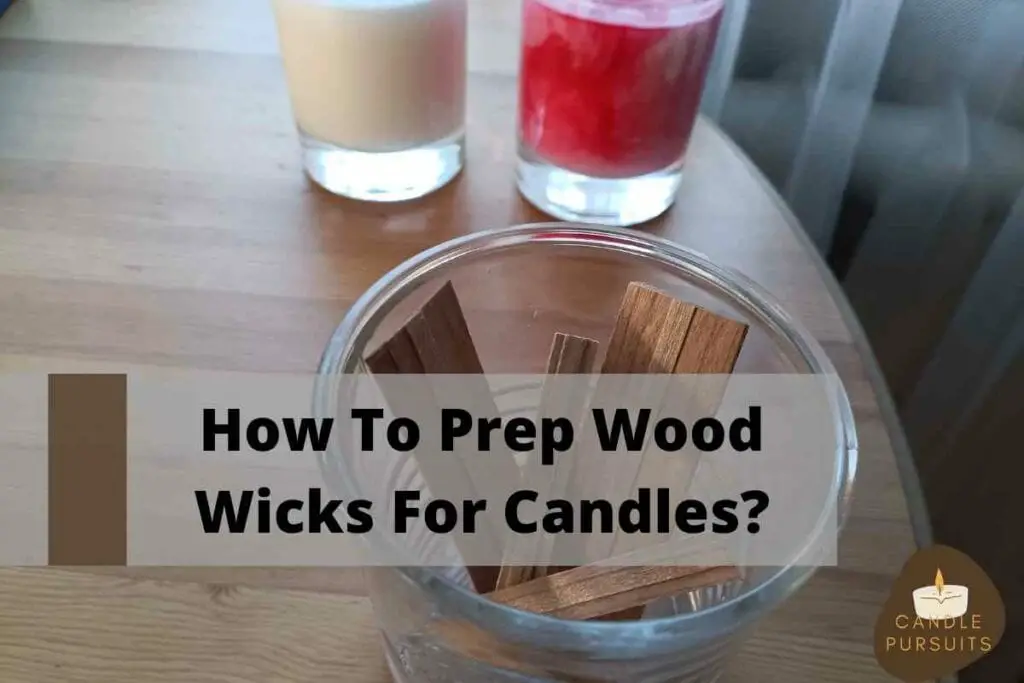Wooden wicks are a unique alternative to the traditional braided cotton wicks. These wicks are super easy to burn, have a natural burning ability, and are versatile to use with different types of wax.
However, making wooden wick candles also calls for additional preparation. In the rest of the article, I will share everything about how to prep wood wicks for candles.
Wood wicks are different from braided cotton wicks as they are simple strips of wood. Just like a cord wick, wooden wicks also tend to be centered in the wax and work by wicking the wax into the flame.
But burning wooden wick candles can be a tricky business if you don’t get their preparation right. Fortunately, prepping wood wicks is quite easy with a bit of help!

Preparing wooden wicks is a bit different than preparing traditional cotton wicks. If you are new to the world of preparing wood wicks, then a bit of help can go a long way! In the rest of the article, I provide a step-by-step guide to preparing wood wicks for candles.
I have also provided different types of wood wicks and the type you should go for. Let’s jump right into it!
Steps To Prep Wood Wicks For Your Candles [Making by Yourself]
The soft crackle and gentle flickers of a wood-wick candle can create the most pleasant and heartwarming atmosphere. However, making a wooden wick candle can be a bit challenging as additional preparation is a must. So I will provide you with a detailed guide to help you prepare the wood wicks properly –
Ingredients You Will Need
- Balsa wood sticks
- Olive oil
- Paper towel
- Wood wick tabs
- Glass jars
- Scissors
- Flat dish
- Wax (soy, paraffin, or beeswax of your choice)
- Wax adhesive
Step 1: Cut some Balsa Wood Sticks
Use scissors to cut the balsa wood sticks to the appropriate wick size. If the wicks are for a certain candle project, it’s best to cut the wood approximately 1 inch longer than the height of your container.
Here I chose balsa wicks as they are the most affordable and easy option. But you can go for the hard or softwood of your choice as well.
Step 2: Soak the Woods and Place in Wick Tabs
Take a shallow dish and place your wood pieces in it. Then pour olive oil all over the sticks to coat them completely. After 20 minutes, remove the sticks and wipe them thoroughly with a paper towel.
Now place the oil-treated pieces of wood into the wick tabs. Make sure you get tabs meant for wood wicks. Tabs designed for cotton or hemp wicks don’t work as well here.
Step 3: Melt Your Wax
Take a heat-safe metal or glass container and measure your wax in it. The amount of wax you use depends on the size of your candle container. To melt your wax, you can use the double boiler method.
In other words, place the container with wax over a pot of boiling water. Take a spare wooden stick to stir the wax until it has completely melted into a clear liquid. Avoid touching the warm glass. Add some drops of candle fragrance of your choice or color it by mixing some tinted wax in there.
Step 4: Warm Up the Jars
Make sure to warm the glass jars before pouring the liquid wax into them. This step helps to prevent any unwanted jump lines from appearing in the finished product.
When you are ready to pour the wax, immerse the uncovered jar in a bowl or sink of boiling water and remove it carefully. The insides of the jars should be completely dry before you move on to the next step.
Step 5: Attach the Tabs to the Bottoms of the Jars
Use some drops of candle adhesive to stick a wick tab into the center bottom of a glass jar. You can also use wax dots to help you center the wick and wick tab after pouring the wax.
This step is also critical for safety as the wick can become off-center as you pour in the wax. If the candle’s flame is close to the edge of the glass jar, it can become dangerous.
Step 6: Pour the Wax Into the Jars
Before this step, make sure to wear heat-resistant gloves or oven mitts. Then slowly pour the warm liquid wax into the jar’s center and cover the wick.
Fill up the jar to no more than 1 inch below the rim’s base. Let the wax completely cool and harden.
Step 7: Trim the Wick
Once the candle is completely cool and hard, you can finish the process by trimming the wick. The wooden wick should have a height of at least 1/3 inch above the wax.
After you have finished the trim, the candle is ready for use! Make sure to be cautious and keep a burning candle always within your sight.
Which Type of Wood Wick Should You Choose?
Unfortunately, you won’t find the single best type of wooden wick to make candles. There are different types of wood wicks out there, and all of them have their unique advantages.
The quality and success of your homemade wood wick candle will largely depend on the width of the wick compared to the size of the holder. Also, whether it is compatible with the wax type and fragrance. There are different types of wood wicks out there, and each of them comes in a variety of sizes.
But their characteristics remain consistent in all categories.
So let’s take a look at the different types of wood wicks out there so you can choose the one most suitable for your candle –
1. Single-ply Wick
Single-ply wicks are the thinnest wood wicks available. As the name implies, it is a single wooden strip with a maximum thickness of 0.04 inches. Its width is limited to 0.75 inches, making it suitable for containers with a diameter of a maximum of 2 inches.
The single-ply wick works poorly with natural waxes. It’s also not compatible with waxes that hold onto extra fragrance oil. Single-ply wicks work best with synthetic waxes such as paraffin or semi-natural mixes like Para-soy wax.
2. Booster Wick
The booster wick, also known as a double wick, is almost identical to the single-ply wick. The key difference is that the booster wick has an additional strip attached to the middle of the wick to increase its thickness.
The additional strip functions as a booster for the thermal output. This unique feature helps the booster wicks work better with natural waxes that retain scent oils and have a low heat output. You can expect the best performance from these types of wicks when using soy wax, palm wax, or beeswax.
3. Spiral Wick
The spiral wick has a unique design, with a hollow center and a tubular shape. The wood is still authentic but has been twisted into a spiral pattern. This wick burns beautifully with a teardrop or cylindrical-shaped flame.
The spiral wick has a high capacity to produce heat, forming wax pools of as much as 3.5 inches in diameter. So these wicks work best with containers that have a large diameter. This sort of wood wick is compatible with all types of wax, whether they are blends of coconut-soy wax or pure beeswax.
Conclusion
If you want to learn how to make wood wick candles, it’s equally important to learn how to prep the wood wicks. While the process isn’t impossible for a beginner, it can still be quite tricky. So in this article, I have provided an easy step-by-step guide on how to prep wood wicks for candles.
I hope the article has been helpful for you. Thanks for reading till now.
